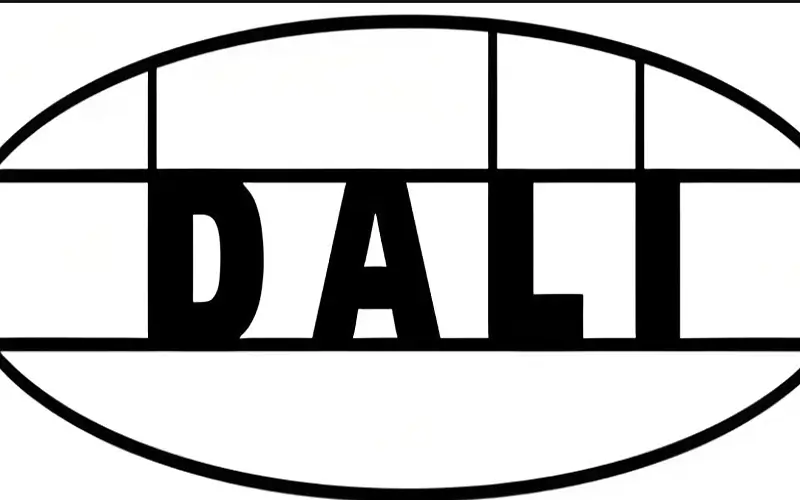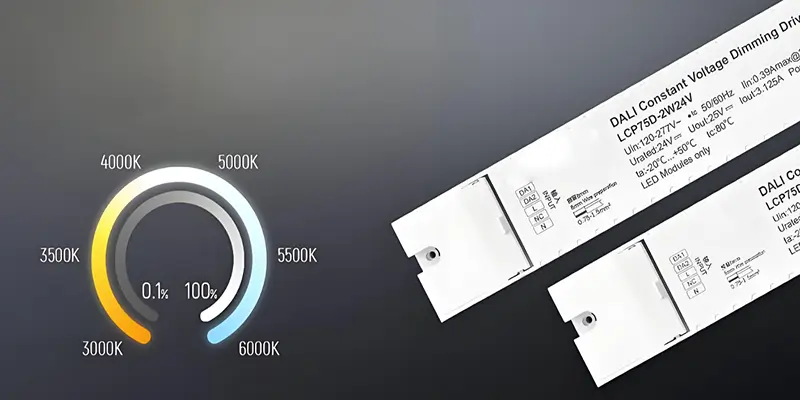
With the development of LED lighting, lighting fixtures are becoming more and more diverse and versatile. Then we have to mention the lighting dimming system. Today’s lighting control systems are becoming more and more intelligent, flexible, energy-saving and precise. And DALI dimming is such a modern system, which stands for Digital Addressable Lighting Interface. This advanced technology has been widely used in commercial, residential and industrial lighting applications.
Let’s learn about DALI dimming together to help you make an informed decision to integrate smart lighting solutions into your environment.
What is DALI Dimming?
If you buy or use dimmable LED lights, you should choose compatible dimmers. DALI dimming refers to a standardized lighting control system that enables seamless communication between lighting devices and the control system.
This is a digital protocol for managing multiple lighting devices, allowing them to be controlled individually or in groups. DALI systems are particularly popular in commercial environments because they offer greater flexibility and customization options than traditional analog dimming systems.
DALI provides two-way communication, allowing each lighting device to be independently addressed and controlled. This feature allows for more complex lighting designs, improved energy efficiency, and a user-friendly interface.

Why is DALI Dimming So Important?
DALI dimming is a good dimming method, and it is so important mainly because it has many advantages in the field of lighting control. It can not only improve the lighting effect, but also enhance the user experience.
Precise Dimming
The DALI dimming system uses digital control to achieve fine adjustment of light brightness. Whether you need to create a soft atmosphere or provide sufficient working lighting, DALI can bring smooth and smooth brightness changes and easily cope with various lighting needs.
Personalized settings
Each DALI device is equipped with an independent address, allowing users to control each lamp individually to achieve personalized lighting configuration. This highly flexible control method makes it easy to customize the most suitable lighting solution according to different scenarios and needs.
How Does DALI Dimming Work?
DALI operates using a two-wire communication system that connects all devices in a lighting network. This system can send control signals to each light fixture or group of lights. A central controller sends digital commands to adjust brightness levels, turn lights on or off, or even change colors in advanced settings.
Each lighting fixture is assigned a unique address, allowing them to be controlled individually. This level of control is ideal for creating dynamic lighting environments in an office, theater, or home.
In addition, DALI systems feature two-way communication, which means that lights can send status reports to the central controller, indicating whether they are operating normally or require maintenance.
Why Choose a DALI Dimming System?
DALI dimming offers several key advantages over traditional lighting control systems, making it the solution of choice for many projects:
Energy saving
DALI dimming allows precise control of light levels. This inherently dims lights when full brightness is not needed, reducing energy consumption and saving money on your electricity bill.
Operational flexibility
With the ability to control lights individually or in groups, DALI dimming provides unparalleled flexibility for creating the perfect lighting environment.
Easy to maintain
Through two-way communication, DALI systems can report faults or maintenance needs, making it easier to manage large lighting setups.
Scalability
Whether you’re working in a small office or a large building, a DALI system can scale to meet the needs of your project.
Automation
DALI can be easily integrated with building management systems to automatically adjust lighting based on occupancy, daylight levels, or time of day.
DALI Dimming VS. Other Dimming Systems
In addition to the DALI dimming system, there are many other dimming systems on the market. You can choose according to your needs.
DALI vs. 0-10V Dimming
When we choose to choose a dimming system, we will definitely encounter the DALI dimming system. Of course, the common comparison object is 0-10V dimming. Both methods provide dimming capabilities, but there are significant differences between them. More information, pls check How Does 1-10V Dimming Work?
The 0-10V system is analog, which means that it lacks the two-way communication function provided by DALI. In the 0-10V system, the control signal is a voltage in the range of 0 to 10 volts, where 0V represents minimum brightness and 10V represents maximum brightness.
Although 0-10V is widely used due to its simplicity, it does not provide the same level of control or flexibility as DALI. For example, with 0-10V, it is not possible to control or get feedback from specific lights individually.
While 0-10V dimming may work for some scenarios, DALI’s more advanced features make it better suited for applications that require greater flexibility and monitoring.
DALI vs. DMX Dimming
DALI is often compared to DMX dimming, another popular lighting control system. DMX (Digital Multiplex) is a protocol used primarily to control stage lights and effects. While both DALI and DMX are digital systems, they differ in key areas.
DMX is a one-way system, meaning it can only send commands to lights, but not receive status updates from them. This limits its ability to monitor the function of lights or adapt to changes in the environment.
Additionally, DMX requires a separate cable for control, while DALI can use the same cable for power and control.
However, DMX has a higher bandwidth than DALI, enabling it to manage more devices with faster response times. This makes DMX ideal for environments such as stage lighting, where fast and synchronized control is essential. For DMX512 controller, pls read What is the Use of DMX512 Controller?
For many other uses, however, DALI’s two-way communication and simplified wiring offer considerable advantages.
Applications of DALI Dimming in Lighting Systems
DALI dimming is used in a wide variety of environments that require dynamic and precise lighting control. There are some environments where lighting is well suited for DALI dimming.
- Commercial buildings: Offices, meeting rooms, and open spaces generally benefit from the flexibility and energy-saving features of DALI systems.
- Residential properties: Homeowners seeking smart lighting control options can use DALI to create customized lighting scenes for different rooms or times of day.
- Theaters and auditoriums: The ability to fine-tune lights for performances and events makes DALI a popular choice for entertainment venues.
- Outdoor lighting: Public places such as parks, paths, and stadiums often use DALI dimming to enhance ambience and safety.
How to Install and Configure DALI Dimming??
Once you’ve confirmed that your LED light strip uses the DALI dimming system, you’ll need to choose your driver dimming system. Especially for voltage and wattage, be sure to choose a compatible DALI dimming system.
Planning Your DALI Dimming System
Before installing a DALI dimming system, serious advance planning is required. Consider the size of your space, the number of lights, and the control settings you want.
Do you prefer to control each light individually, or is it more practical to group them? Determine which sensors or switches are needed and how the system will integrate with existing building systems.
Addressing these questions will help you choose the right components and determine how to arrange them. It’s also wise to consult a lighting expert or electrician familiar with DALI systems to ensure your design meets your requirements and complies with regulations.
Installing Your DALI System
After planning, the next step is to install your DALI system, which includes setting up your DALI controller, lights with DALI drivers, and any sensors or switches.
One of the benefits of DALI is its simple two-wire connection, which can often be integrated using existing wiring, making installation less of a hassle. However, to ensure safety and proper functionality, it must be installed by a qualified electrician. Once everything is in place, each light must be assigned an address.
Depending on your controller, this process can be done manually or automatically. Once the lights are addressed, you have full control over your lighting system.
Configuring Your DALI System
The final stage is to configure your DALI system to take full advantage of its capabilities. This involves programming your DALI controller to set desired brightness levels, establish lighting scenes, and integrate sensors or switches.
Many controllers come with user-friendly software that can be adjusted via a computer or mobile device, giving you the flexibility to fine-tune your lighting.
DALI can also link to building management systems for enhanced control and efficiency. Proper configuration ensures smooth operation and ensures your DALI system functions as intended.
Troubleshooting Common Problems with DALI Dimming
When our LED strip lights use DALI dimming lighting, the following problems may occur. You can also follow the following problems to troubleshoot.
Insufficient Dimming Range
A common problem encountered with DALI dimming systems is insufficient dimming range, where lights may not dim as expected or transition smoothly between brightness levels. It is possible that the DALI controller is not configured correctly or is incompatible with the lighting fixtures.
Let’s first troubleshoot if this is the issue. To do this, check the settings on the DALI controller and verify that the lights are fully compatible with DALI dimming. If the issue is not resolved, it may be helpful to consult a lighting expert or contact the DALI system manufacturer for further guidance.
Flickering Lights
Light flickering is a common problem in DALI dimming systems. This is especially true when the lights are dimmed to lower levels. This flickering can be caused by a number of reasons, including power supply problems, DALI driver failure, or problems with the lights themselves.
If you do have a problem with light flickering, check the stability and quality of the power supply. Next, check the DALI driver and lights to ensure they are compatible with each other and the DALI system.
System communication errors
Communication errors can also occur in DALI dimming systems, causing the DALI controller to be unable to communicate with the lights and lose control of the lighting. If such a problem does occur, it may be a problem with the DALI controller or the lights themselves.
Then we need to check whether the wiring is installed correctly and whether there are any signs of damage. In addition, verify that the DALI controller and lights are operating as expected. If communication problems persist, it may be necessary to consult a lighting expert or contact the system manufacturer.
Conclusion
DALI dimming is a powerful and versatile lighting control system that provides precise control and scalability, making it a top choice for homes to large commercial properties. By understanding the capabilities of DALI dimming and how it compares to traditional systems, you can better understand the role it can play in enhancing the user experience and operating efficiency of your lighting system.
